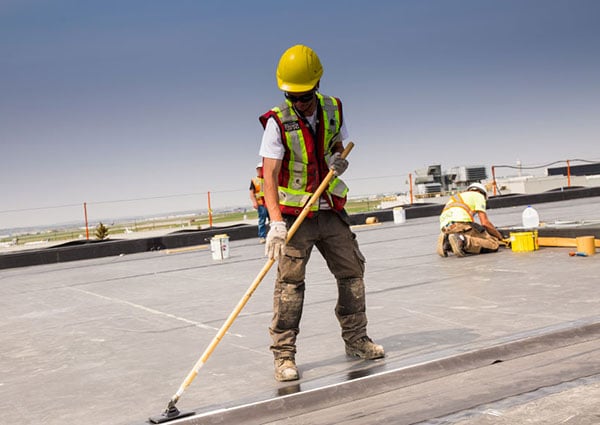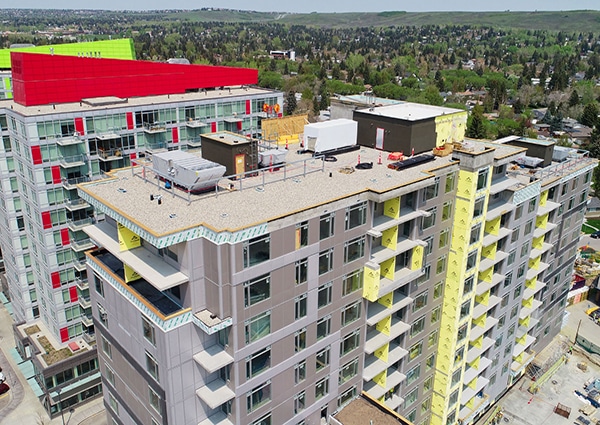What is the Best Material for a Flat Roof?

If you’re looking to install a commercial flat roof, the most important decision you’ll need to make is probably which material to use.
Your decision can be the difference between your roof lasting 10 years and 70 years. It can also make or break your budget.
So, it’s a big call.
The information below should hopefully make it a little easier to decide.
Why are flat roofs preferred for commercial buildings?
Flat roofs are the most popular type of roof for business premises around Alberta.
While you’ll also see low-slope roofs around Calgary and Edmonton, most commercial building owners opt for the practicalities and the economical benefits of flat roofs.

Flat roofs are usually constructed with a very slight slope to allow for some water runoff (between 1/4 to 1/2 inch per foot) despite their name.
The runoff issue is considered the main potential downside of flat roofs. Pooling water on a commercial flat roof can cause water damage and leakages, so you must take measures to prevent this from occurring (which generally means more maintenance).
As you will see below, the climate plays an important role in the design of almost any roof in Alberta.
With flat roofs, you have many possible choices of roofing material.
Unlike low-sloped roofs, they do not necessarily need to be constructed with a membrane to seal the roofing material.
While steep-slope roofs are great for water runoff, they are seldom used on commercial properties because they are more expensive and the choice of materials is more restricted.
REQUEST A CONSULTATION
Factors That Affect The Longevity of a Flat Roof
The durability of your flat roof will determine the value-for-money you get from it.
We have several climatic factors here in Alberta that other parts of the country don’t experience. That will affect your choice of material but there are other important factors to weigh up too.
So, let’s go through the main ones:
The Climate
We have the type of climate here in Alberta that can be tough on a roof, no matter what material it is made of.
Commercial flat roofs face long winters with freezing temperatures, ice, and heavy snowfall, as well as humid summers, hail, and storms. This can cause damage that shortens the life of your roof unless you choose a material that is designed to withstand the extremes and maintain it well.
Just recently, we had a hailstorm in Calgary that wrecked a lot of roofs and caused many millions of dollars worth of damage for business owners.
Regular freezing and thawing of water can also create big problems. When moisture seeps into gaps and refreezes, it can potentially lead to cracks and leaks in your roof.
Design
We’ve touched on this already. Roof design greatly affects the runoff of water and the amount of debris that will accumulate on it.
When water cannot flow off the roof, it finds the lowest point and stays there until it evaporates, in the process of creating water damage and leaks.
Flat roofs tend to fare worse than low-slope roofs with this but the greater flexibility with materials and ease of install of flat roofs helps you remain within tight budgets. You can compensate for potential water pooling by maintaining your roof well and checking for water problems regularly.
It’s not only flat roofs that face issues with the climate. Snow can still accumulate on low-slope roofs and high-slope roofs are rarely used for commercial properties partly because they fare poorly with the wind.
Installation
If you hire professionals like the team at United Roofing Inc. to install your roof, the job will be completed professionally regardless of the design or materials.
Poor workmanship is responsible for reducing the life of many a roof around Calgary and Edmonton.
A good example of this on a metal flat roof is trying to cut corners by using fewer fasteners to secure the roof. That’s potentially disastrous when the first storm arrives.
Make sure you hire the right team to install your flat roof regardless of the material you choose or your preferred design.
Ventilation
Direct sunlight, excess water, and heat can all cause degradation of roofing materials and lead to other problems with your roof.
Installing your commercial roof with adequate ventilation is essential for maintaining its health and longevity. This is something that your United Roofing Inc. consultant can advise you on.
Our local knowledge and experience in commercial roofing environments around Calgary and Edmonton will help minimize problems with ventilation.
Maintenance
There is probably no such thing as a “maintenance-free” roof. If you don’t regularly check your roof for signs of damage and call a professional roofing company to inspect your roof at least once a year, you’re asking for trouble.
A commercial roof is a major investment and like all such investments, you need to protect it. So, introducing a regular maintenance plan should be a priority after installing your roof.
Material comparison
The generally accepted lifespan of a commercial roof is anywhere from 10 to 75 years.
That’s a huge difference that will impact your return on investment significantly. As we’ve seen, your choice of materials for a commercial flat roof is one of several major contributing factors to its lifespan.
The table below compares the most common materials you will see on flat roofs around Calgary and Edmonton:
Material |
Pros |
Cons |
Lifespan |
|---|---|---|---|
| Metal Roof |
|
|
|
| EPDM Membrane |
|
|
|
| TPO Membrane |
|
|
|
| PVC Membrane |
|
|
|
| Modified Bitumen |
|
|
|
| Built-up Roof (BUR) |
|
|
|
Need help choosing your flat roof material?
If you’re looking to install a commercial flat roof in the Calgary or Edmonton area, the quality of advice you get may be just as important as the quality of the material you choose.
We can help with both the planning and installation of your roof.
Frequently Asked Questions
Most commercial building owners opt for the practicalities and the economical benefits of flat roofs. With flat roofs, you also have many possible choices of roofing material.
The climate, Roof design, Installation, Ventilation and Maintenance are some of the most important factors.
Anywhere from 10 to 75 years.
